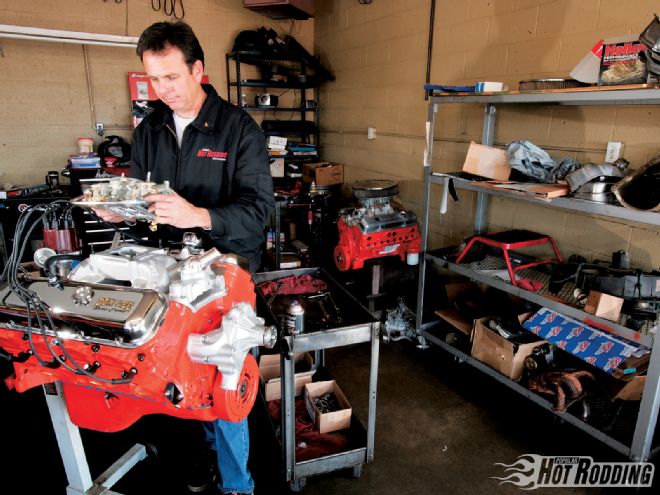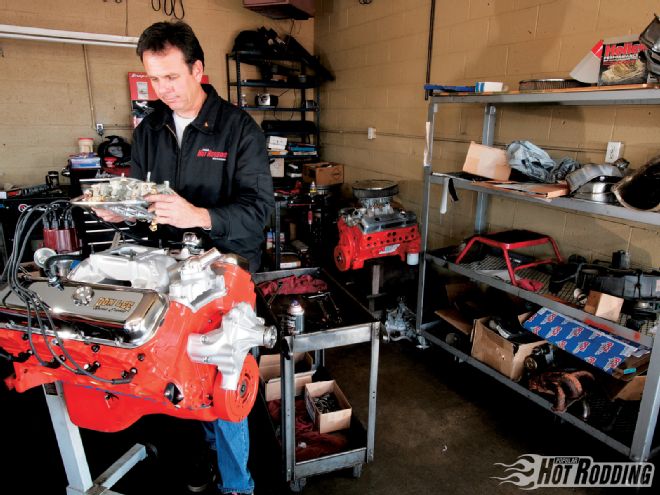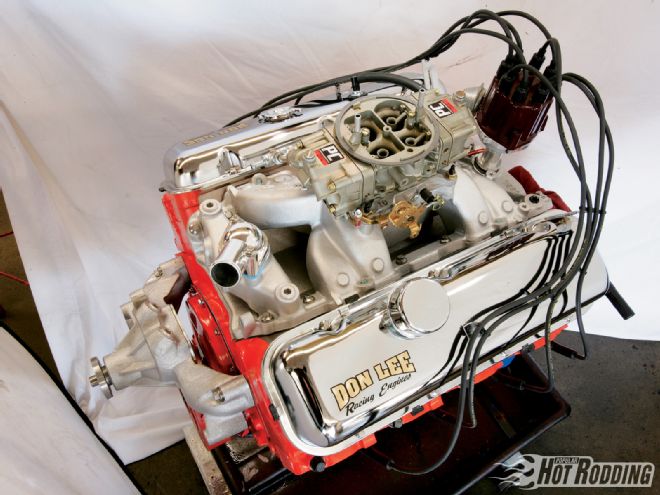
What makes a good street engine? The answer to this can vary depending on the goals of a buildup, but there are several factors that apply to a big slice of us regular-guy hot rodders. We see lots of cost-no-object buildups-you know, the thing where just the carb costs a month's pay. Building such an engine front to back costs several times more than your street project sitting in the garage. For guys with that kind of budget, there are plenty of choices, but if the spare cash is thin, all you can do is flip the page and dream. What about a big-block Chevy that uses affordable parts and hits like a wrecking ball when the throttle is stomped? That was the idea behind the Street Brawler 496.

The basis for our engine is the 454 pulled from Hunkins' Chevelle. Far from exotic, it was just a common low-compression, small-port truck motor; the kind that still shows up in junkyards and swap meets. We wanted an engine that anyone can put together in their garage, without needing a full machine shop to get it done. This is a big-block Chevy that goes together pretty much like a stock rebuild, but packing some serious punch.
The Bottom End
Although we were going to keep it cheap and real, there was no intention of doing a dingle-ball hone and re-ring overhaul on this 454. The engine showed normal wear for a twenty-plus year-old piece, and the objective was a full rebuild. When you look at the balance between cost and power potential, using a stroker combo has too much going for it to pass up. Considering the used core needs crank and rod reconditioning, boring, and new pistons just for a stock rebuild (not to mention re-balancing), a stroker kit becomes pretty attractive. For $1,249 with bearings, an Eagle stroker kit is a real bargain for the extra 42 cubic inches. When you subtract out the cost of the pistons, rings, a crank grind, rod reconditioning, bolts, balancing, and bearings for just a stock 454 build, a 496 combo is pretty hard to pass up. A stroker is the fast path to massive torque, and the economics just make sense. Add in the fact that the stroker pieces are matched, balanced, and ready to go; it sure looks attractive compared to hauling the old parts in and having to wait while they are re-worked.

Eagle has a variety of parts at different price levels, including forged cranks, H-beam rods, and forged pistons. We went with a more basic internal assembly, with a cast crank, budget I-beam rods, and hypereutectic pistons. The reasoning here was cost-to-benefit. If we were going with a high-rpm racing combo, the added insurance of high-end parts certainly adds peace of mind, but taking a realistic look at our objectives, the standard Eagle stuff is plenty stout to meet our needs. Reliability has a lot to do with rpm, and with 496 cubes working for us, there is no reason to wind the guts out of an engine this big for the street. Our plan was to let the displacement do its stuff lower in the rpm range, with a modest target of under 6,000 rpm. Shooting for a moderate rpm range dovetails with the budget approach throughout the build.
Since the Eagle internals provide practically everything needed to fill the block, there wasn't much to do on the machining front before the engine was ready to assemble. The stock block went to Andy Mitchell's Outlaw Racing for cleaning, inspection, and a bore and hone job, and that was it. It was pretty nice to walk out of the machine shop with only a $235 bill. Besides the bore prep, there was some clearancing of the block needed to accommodate the stroker crank's longer throw, and it was time to start putting the bottom end together using the all-new parts. The stroker kit went together about as easily as a stock rebuild, but the added cubes will pack a noticeable punch once the engine is completed.
Power Parts:
Cam, Induction, Heads
One of the nice things about a stroker combo is it moves the rpm range lower for a given power level, and this factor would figure in with our cam choice. Hands down, the cheapest way to cam an engine is a hydraulic flat-tappet; the only down side is that a juice cam doesn't particularly like high rev's. With the stroker's rpm range, a flat tappet is more than a viable choice; it is perfectly capable of providing the engine's needed valve action. Still, with all those cubes to feed, a healthy stick is the right call, so a COMP 292 Magnum cam was the choice. With 244 degrees duration at .050, and a .550-inch lift, the 292 Magnum cam is stout enough to feed the beast. Being a hydraulic, we could pretty much forget about it once installed. On the recommendation of cam guru and PHR contributor, David Vizard, we had this ground on a 108-degree lobe separation angle, which David swears is the cat's pajamas. (Hence, the custom part number you see in our spec chart.) Another way the hydraulic fit with our budget plans is that it is happy to work with inexpensive hydraulic lifters and a cost-conscious valvetrain. We used COMP Magnum rockers, and the stock single springs supplied with our heads.
The head choice can make or break both the budget and performance of an engine like this. Rather than mess with a stock set of small-port truck heads, a new set of iron Summit rectangular-port heads were chosen. Not only do these have a much higher capacity than late-model stock big-block heads with their 308cc intake runners, but they also come complete and ready to rock with valves, springs, retainers, studs, and guideplates. Like going with the stroker bottom end, replacing the heads instead of rebuilding stock stuff is quite a good value, especially if you consider the costs of reconditioning and upgrading a used set. The Summit heads (which are made by Dart) require longer pushrods than stock, and to determine the exact length required, it is best to mock-up the heads and measure what's required on your particular block with a checking pushrod.
Topping the heads is the induction, and here we again stuck to our lower rpm torque plan with a two-plane Edelbrock Performer RPM Air-Gap intake. Within a street rpm range, these intakes don't give much up to a single-plane in top-end power, but add big gobs of torque, making it an ideal choice for our street 496. We saved some coin on the carb, going with a swap meet Holley 750 we picked up for $75. We had the carb fully restored, modified, and rebuilt with an 850 baseplate by Performance Carburetors of Ontario, California, and came away with a great carb for about half the cost of a new piece. These guys do great work. With that, most of our build was completed with no surprises, and the finishing touch was to re-install the MSD distributor that came with the engine core, and add a set of MSD's new Street Fire wires. All in, we had about $5,500 in building the 496, an amount you can easily exceed even when rebuilding a stock-displacement 454.
Test Time
Though our engine had grown to a 496, it was a pretty basic package not far removed from what the old-school street-build guys have been doing to 454s for decades. We brought the engine to Westech Performance Group in Mira Loma, California, to put it through its paces. With a flat-tappet cam, the break-in period is critical. For added insurance, a pint of COMP's Engine Break-In Oil Additive (PN 159) was poured into the crankcase before the engine was fired and run through the dyno's automated break-in cycle. Don't skimp on the cam break-in with any flat tappet, and make sure the engine is dialed in and ready to fire before attempting to start it for the first time.
Before long, we were ready for the power pulls, and here the stroker showed its fat arm in action with torque rolling in hard right from the bottom of the pull. In fact, with some tuning of the jetting and timing, the 496 was belting out 550 lb-ft right at the bottom of the test range at 3,000 rpm. That's torque that a pump-gas 454 just can't deliver. Torque peaked at 582 lb-ft over a range from 3,800-4,200 rpm, while the engine kept making steam for a power peak of 567 hp at 5,700 rpm. The engine showed a broad power curve at a moderate rpm level-just the thing for a reliable and fun street ride. When it comes to making power on a budget, size counts, and the torque over the operating range of this engine will make it a much sweeter street mill than a smaller engine making similar power at a higher rpm, and without the low-end torque. With power this cheap and easy, what are you waiting for?
WHERE THE MONEY WENT Part: Source: Part Number: Price: 454 core project Chevelle n/a $600 (market value) Eagle 496 stroker kit Eagle n/a $1,249 Cam bearings Summit/Clevite CLE-SH616S $21.95 Flat-tappet camshaft COMP 11-000-5 $165.69 Double-roller timing set COMP 2110 $41.95 Standard volume oil pump Melling M77 $27.95 Oil pump pick-up Milodon 18300 $42.95 Deep sump oil pan used/Milodon 31100 $30.00 Master gasket set Fel-Pro KS 2618 $61.95 Expansion plug set Summit SUM-G1582 $16.95 Oil pump driveshaft Melling IS-77 $11.39 Main bolts ARP 135-5002 $33.95 Hardened pushrods (int.) COMP 7934 $131.12 Hardened pushrods (ex.) COMP 7757 $135.92 Roller-tip rockers COMP 1411-16 $159.95 Lifters COMP 812-16 $72.95 Assembled iron heads Summit SUM-152125 $645.95 x 2 Head bolts ARP 135-3601 $59.95 Spark plugs (8) Autolite 3924 $12.00 Aluminum water pump PRW 1445401 $95.95 Dual-plane intake Edelbrock 7562 $239.95 Water neck Spectre 42313 $9.99 Distributor MSD 8360 n/c (came w/core, Summit price $306.60) Plug wires MSD Street Fire 8mm 5561 $39.99 Carburetor Holly/PC Carb n/a $495 (core plus rebuild cost) Carb fuel log Professional Products 10421 $39.95 Carb stud kit Spectre 42513 $6.99 Accessory bolt kit ARP 535-9601 $111.95 Oil filter ACDelco PF454 $4.95 Valve covers generic chrome n/a $29.00 Breather Spectre 4277 $4.99 Engine paint (2 cans) Dupli-Color DE 1607 $9.98 Parts Total: $5,273.16
Machine Work: Balancing of rotating assembly (included in Eagle kit price) n/a Block bore and hone Outlaw Racing $235 Parts and Labor Total: $5,508.16
DYNO RESULTS
496 CHEVROLET BIG-BLOCK SUPERFLOW 902 ENGINE
DYNO TESTED AT WESTECH
RPM
TQ
HP
3,000
555
317
3,200
556
341
3,400
573
371
3,600
579
397
3,800
582
421
4,000
582
443
4,200
582
465
4,400
578
484
4,600
575
504
4,800
570
521
5,000
561
534
5,200
553
547
5,400
544
559
5,600
531
566
5,800
513
567
6,000
491
561
CYLINDER HEAD FLOW
SUMMIT/DART HEADS
VALVE
INTAKE
INTAKE
EXHAUST
LIFT
cfm
cfm
cfm:
(poor)
(good)
.050
35.5
32.4
31.5
.100
72
69
66
.200
144
143
103
.300
196
197
152
.400
247
249
188
.500
286
292
217
.600
307
320
240
.700
307
326
256